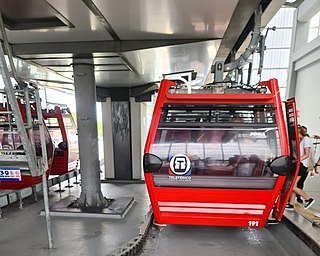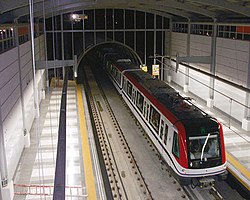
Santo Domingo, once known as Santo Domingo de Guzmán, known as Ciudad Trujillo between 1936 and 1961, is the capital and largest city of the Dominican Republic and the largest metropolitan area in the Caribbean by population. As of 2022, the city and immediate surrounding area had a population of 1,029,110 while the total population is 3,798,699 when including Greater Santo Domingo. The city is coterminous with the boundaries of the Distrito Nacional, itself bordered on three sides by Santo Domingo Province.

Alta Velocidad Española (AVE) is a high-speed rail service operated by Renfe, the Spanish State railway company.

The Santiago Metro is a rapid transit system serving the city of Santiago, the capital of Chile. It currently consists of seven lines, 143 stations, and 149 kilometres (92.6 mi) of revenue route. The system is managed by the state-owned Metro S.A. and is the first and only rapid transit system in the country.

Juanacatlán is a metro station on the Mexico City Metro. It is located in Mexico City's Miguel Hidalgo borough in the San Miguel Chapultepec neighborhood, and lies on Line 1 of the Metro. In 2019 the station had an average ridership of 11,669 passengers per day, making it the least used station in Line 1. Since 9 November 2023, the station has remained closed for modernization work on the tunnel and the line's technical equipment.

Universidad is a station on the Mexico City Metro. It is located in the southern reaches of Mexico City, in Coyoacán borough. A surface station, it is the current terminus of Line 3. The station was opened on 30 August 1983. In 2021, the station had an average ridership of 25,858 passengers per day, making it the fifteenth busiest station in the network.

San Cosme is a station on Line 2 of the Mexico City Metro system. It is located in the Cuauhtémoc municipality of Mexico City, northwest of the city centre, on Avenue Ribera de San Cosme a few blocks before it becomes Calzada México-Tacuba. The southern exit leads to Colonia San Rafael while the Northern one leads to Colonia Santa María la Ribera. It is two blocks from the Mercado de San Cosme. In 2019, the station had an average ridership of 22,891 passengers per day.

Metrorrey, officially Sistema de Transporte Colectivo Metrorrey, is a rapid transit system in Monterrey, Nuevo León, Mexico. Operations began in 1991. As of 2021, the system operates 50 high-floor electric trains, along a total system of 40 stations with a length of 40 kilometers (25 mi).

The Alstom Metropolis is a family of electric multiple units designed and produced by the French rolling stock manufacturer Alstom. It is designed for high capacity rapid transit or metro rail infrastructure systems. Trains can be run in various configurations, the length alone varying between two and ten cars; it is also suitable for both manned or unmanned operations.

The Sistema de Tren Eléctrico Urbano or SITEUR is an urban rail transit system serving the Guadalajara metropolitan area, in the municipalities of Guadalajara, Zapopan and Tlaquepaque, in the state of Jalisco, Mexico. It is owned and operated by the state of Jalisco.

Mixcoac is a station on Line 7 and Line 12 of the Mexico City Metro. The station serves both lines as a transfer station and as the northwestern terminus of Line 12. In 2019, the station had an average total ridership of 54,963 passengers per day.

Mexico City Metro Line 1 is one of the twelve Metro lines operating in Mexico City, Mexico. Officially inaugurated in 1969, it was the first metro line to be built in the country. Its identifying color is pink and it runs through the city from west to east.

Mexico City Metro Line 3 is one of the 12 metro lines built in Mexico City, Mexico.

The Panama Metro is a rapid transit system in Panama City, Panama. It links neighborhoods north and the east of the metropolitan area to the city center.

Santiago Metro Line 1 is the oldest of the seven existing rapid transit lines that make up the Santiago Metro system. Being its busiest, it has a total of 27 stations along its 19.3 km (12.0 mi) length, constructed almost entirely underground, and is located primarily along the axis formed by the Avenida Libertador General Bernardo O'Higgins, Providencia Avenue and Apoquindo Avenue.

Santiago Metro Line 6 is a line on the Santiago Metro, Santiago, Chile. It connects the commune of Cerrillos, in the south west of the city, with Providencia in the east of the city, where most economic activity is concentrated. It has 10 new stations on 15.3 km (9.5 mi) of track. Its distinctive color on the network line map is purple.

The Teleférico de Santo Domingo is an aerial cable car urban transit system in Greater Santo Domingo, operated as part of the Santo Domingo Metro. It is the first urban-transport aerial cable car line in the Dominican Republic. It functions as a typical monocable gondola, and runs for 5 kilometers and a total of four stations, and is connected to the Santo Domingo metro system.
Juan Bosch is a Santo Domingo Metro station on Line 1. It was open on 22 January 2009 as part of the inaugural section of Line 1 between Mamá Tingó and Centro de los Héroes. The station is between Juan Pablo Duarte and Casandra Damirón.























